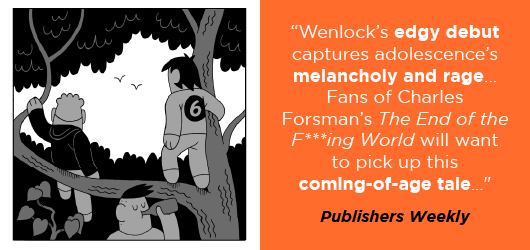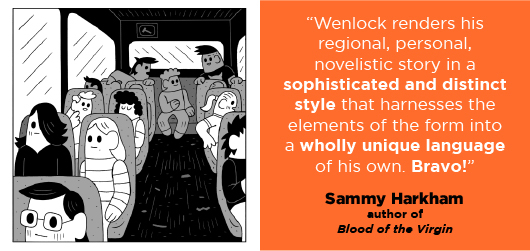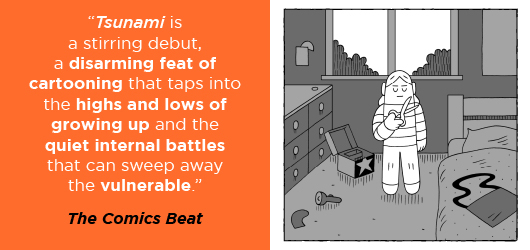"I Think This Book Really Got Under People’s Skin": Graphic Novelist Ned Wenlock on Tsunami
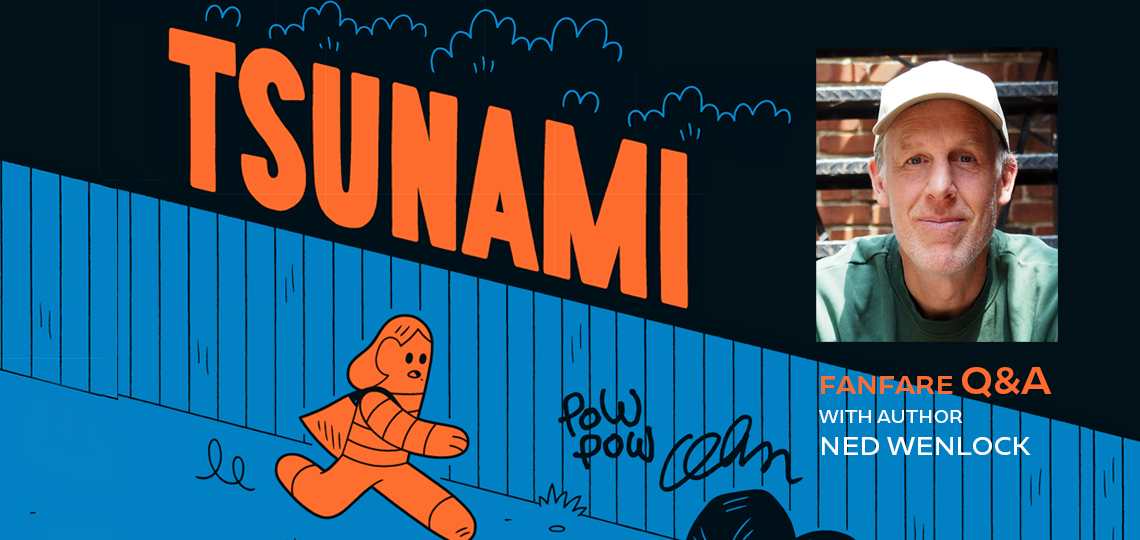
Reviewer Peter Dabbene Interviews Ned Wenlock, Author of Tsunami
Like all authors, graphic novelists are faced with decisions about how best to put their story into words: plot, characters, themes, tense, timelines, tension building, and all the rest. But that’s only half the puzzle for the illustrated book creator because the art of the story—the images used to move the story along, the pictures worth a thousand words—are what make graphic novels perhaps the hottest genre in the book industry.
Today, we’re with the immensely talented Ned Wenlock, and based on some of his answers in the interview below, we get a sense of how an artist, a visual person, thinks about the interaction between words and images in a book. Exhibit number one: when Ned—whose background is in animation—came down to final decisions about how best to deliver Tsunami to readers, he made the wrenching decision to cut one hundred finished pages from the book: “Animation has taught me not to be precious about my work, the end result is what matters.”
Earlier this summer, Tsunami scored a sparkling review from Peter Dabbene in the pages of Foreword, and we jumped at the chance to connect reviewer and artist for a thought-provoking conversation.
The title Tsunami is perfect for the book, giving a sense of a looming, destructive wave that we know is coming, but can’t see until it reaches its full force and it’s too late to stop it. How early into the project did you decide on that title, and did you ever consider anything else?
Tsunami as a title was there from the start. I like to work towards a title if possible, because it constrains the story and keeps me focussed.
Before I became self-employed, I used to find work quite stressful. I would get these recurring dreams about giant walls of water finding me in a house, or on top of a hill or something, and there was nowhere to hide. The title Tsunami is very much about stress, and the build up of stress, until the giant wave hits you. It was perfect for the journey I had planned for Peter, the main character.
Another title I considered briefly was “Badass,” taken from some conversations between characters in the book. This was when I was struggling with the ending of the book, and trying things out. One ending was quite upbeat, more like a traditional young adult book, and I thought “Badass” conveyed a slightly humorous tone, particularly when matched on the cover with a picture of a diminutive Peter. However, that ending felt very out of place with the darker tone of the rest of the book. Sometimes I find you just need to try things to realise you were on the right track all along.
Given its subject matter—an alienated teenager, struggling to adapt to his surroundings—the story resonates on several levels. With unfortunate occurrences of violence among teens being an occasional item in the news, was there any particular real-life event that inspired Tsunami?
No, nothing directly from real life, but I have seen news items about kids doing terrible things, and I think the news media eventually being involved in the story of Tsunami helps to make it feel real. I did use moments from my own life, so although the story is invented, parts of it are real, which again helped me describe what a particular moment felt like in a truthful way.
There’s a scene near the start where Gus, the boy from next door, gets Peter in a headlock, and chokes Peter on his own bed. For that scene, I was looking for a way to show proof of a threat, I wanted it to feel legitimately dangerous to the reader. And this memory from boarding school came up, where a much bigger boy in my year did just that to me. He said all the same things too, but unlike Gus, he didn’t have an agenda, which made it even scarier. Sometimes kids are trying things out, which makes them unpredictable, not only to others but also to themselves, and that’s the threatening feeling I wanted, like this could unexpectedly end badly. I was able to get inside that feeling, and translate it into the comic form, simply from my own moment-by-moment memory of it. I also think this helped inform how the characters acted afterwards, because the characters themselves, in my head, now have these memories and trauma, and this made them act against their better judgement.
On a lighter note, there’s a scene right at the start, where a grandma swears at her grandkids for swearing. That’s something I overheard happening next door! It’s so ridiculous, I’d never think to make it up. So yeah, real life events do inform the story in many ways.
You come from an animation background, and Tsunami is your first book. What drew you to the graphic novel format, as opposed to telling this as an animated story? Any particular comic book/graphic novel influences that made an impression on you? Is an animated version of Tsunami, or even a live-action film a project you’d consider, or do you see it as its own unique graphic novel story?
The majority of my animation projects have been solo ventures. Sometimes if the budget allows I employ character animators, but most of my work is low-budget, particularly my personal projects, so it can be quite a slow process, and this time factor limits me to short animations.
Tsunami was always going to be a longer story, and maybe not an easy story to find a budget to make into an animated film (with the kind of team that I’d need to make it in a timely manner), so a graphic novel, with its low overhead, made sense. I think now, having made Tsunami as a graphic novel, I can’t really see it as an animated film. The story, the feeling of the story, is all tied up in how it’s told, in this graphic novel format which I’m very happy with. There is something totally introspective about comics, the tight connection between the reader and the book, that really works for this tense, claustrophobic tale.
One major influence was Yoshihiro Tatsumi’s The Push Man and Other Stories, published by Drawn and Quarterly. The format is similar, right down to the blank white pages that separate the stories (this to me is like the comics version of cutting to black in a film). These are moody short stories, often about the repercussions of a decision made by the main character in a world not at all attuned to the individual. You could call it immersive noir, that was the feeling I wanted for Tsunami.
Your art style in the book is wonderful: deceptively simple in appearance but so effective in capturing mood, action, and emotion. Many pages feature twelve panels, which would normally make for a pretty packed layout, but the flow of silent panels and dialogue makes it all work together seamlessly. Was it an easy decision to go with this simplified art style? Was it driven primarily by storytelling, efficiency, or a bit of both?
I’ve actually been drawing in this style for quite a while now. It developed in this very simplified way because I didn’t have a lot of time between work and family to draw comics, and I wanted a shorthand aesthetic that was pleasingly graphic that I could use to draw short, funny stories.
The concept for these balloon-looking characters came from old tin toys, and Mexican pottery. With both you have the simple outline shape of the object or character, and any detail is printed or painted on top. Most of the characters are the same shape, which is easy to draw, with the same eyes and mouth. To differentiate them they have unique hair and clothes. The very simplicity of this style does present its challenges however. For instance, I wanted to have Peter cut his hair in the story, and as you can imagine he would look unrecognisable, so I gave him a mole on his chin to define his face. Characters changing clothes or wearing hats is also a bit of a challenge, or even relying on facial expressions to convey emotions. It just means I have to find roundabout ways to do these things.
Tsunami is the first time I’ve tried using this style on a more serious story. It’s been interesting getting people’s responses—thinking it’s going to be a light story, maybe funny, purely based on the cartoony style, and then finding it darker than expected. It’s kind of fun to play against conventions.
Depicting the flow of time, whether long or short, is also something you seem to have mastered from the start of your graphic novel career. Your panels seem to speed up or slow down the pace exactly as the story warrants; it reminded me of a conductor leading an orchestra. Did you find it to be a natural, intuitive aspect of pictorial storytelling, or did you have to work at it? How would you compare the transition from animation to single panels?
I think my experience as an animator has certainly helped my comics. With animation you spend a lot of time in the minutiae of a single moment, particularly with commercial animation where every second counts. The animation rule that stands out to me in terms of storytelling is to focus on one piece of information at a time, don’t have multiple things occurring on the screen concurrently. So applying this to Tsunami—as you mentioned there are often many panels on a page—and every panel is just one piece of information: talk, response, glance, sigh, etc. This is easier to absorb, and draws the viewer in, plus it’s a good way to play with time because the panels act like the beating of a metronome.
Additionally, I think about the camera a lot, the viewpoint and where the camera should be to convey a feeling. Close up, far away, above, etc. And cutting, the timing, cross-cutting, and the flow of cutting during dialogue.
And finally, just cutting dead wood from the plot—I drew an extra one hundred finished pages of Tsunami that didn’t make it into the final! Animation has taught me not to be precious about my work, the end result is what matters.
Tsunami seems like the kind of book that would be a valuable addition to high school libraries and discussion groups. Have you gotten any feedback from schools, teachers, counselors, or psychologists?
Tsunami has been a great talking point for sure; out of all the works I’ve created I think this book really got under people’s skin, and garnered the most opinions. Funnily enough, I was always too afraid to be real or genuine in my earlier comics and short films because I didn’t like the idea of being judged. But having tackled more serious themes now with Tsunami, I see it’s not about me at all, it’s the work itself that’s being judged. To be honest, some people really hate the story (and want to tell me why!), but many others absolutely love it and are able to give me their own insights that illuminate something I’ve never thought about before. I knew writing it that it would be polarising, I wasn’t trying to be edgy or anything, but the path the story follows is unpredictable, and a little out of control, and that can be unsettling for some.
When it won the NZSA Best First Book Award here in New Zealand, it was bought by libraries throughout the country, and I’ve seen it pop up in “librarians’ choice” lists quite a bit. I do think it would be a good talking point in schools, addressing bullying for one, but also the dangers of righteous ideology, with its narrow unforgiving viewpoint for another.
After such an impressive debut, do you plan to continue working in the graphic novel format? Any specifics for your next project?
Time will tell, I often have false starts before something interesting takes hold. When I finished Tsunami I took a break for a bit, and then launched into a new story, this time set in the ‘80s, about two fourteen-year-old boys who accidentally come across an assault happening on the way to the beach. It was going to be about movies and entertainment getting mixed up with memory, creating a distinct feeling for a time that becomes nostalgia. But when I showed the first chapter to my daughter (who is in her early 20s) she looked at me in horror and told me it was too disturbing. And I think she was right. I was following a downward trajectory from Tsunami, going even darker. I hadn’t taken a long enough break.
That was a year ago, and I don’t have anything concrete yet, but I’m working on a new story that I hope develops into a book. I just have to show it to my daughter first …
Tsunami
Ned Wenlock
POW POW Press (May 6, 2025)
A high school boy seeks his place in the world in Ned Wenlock’s absorbing graphic novel Tsunami.
Peter doesn’t fit in with his peers. A drawing assignment makes this clear: Gus, Peter’s neighbor, draws a wolf attacking sheep, while Peter draws a sheep surrounded by wolves and compares the predators to his classmates. Peter’s pain is relieved by his friendship with Charlotte, the new transfer student. Still, amid his parents’ marital stresses and a misunderstanding about money, Peter’s situation worsens and tensions escalate, leading to a shocking tragedy.
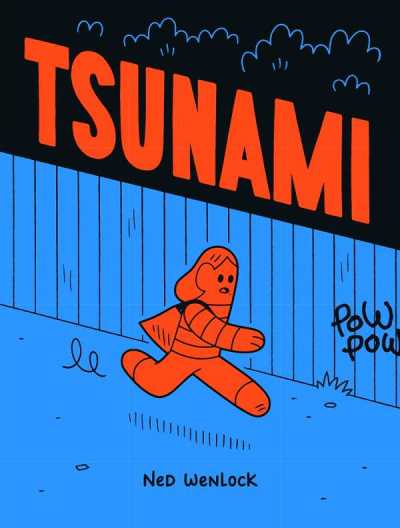
The book’s art is simple at first glance but proves charming and effective, conveying deep truths about the characters through their subtle and overt actions and expressions. It captures the sharp emotional swings of adolescence, as when Peter and Charlotte watch a man get tangled in his dog’s leash and fall; they both laugh, but within moments, they are overcome with sadness. Peter also grapples with the confusing complexity of mixed messages from his parents and classmates.
Pacing and foreshadowing prove key: One small event heralds others and leads to the next, resulting in momentum and a sense of a looming disaster. Throughout the book, glimpses of hope battle with foreboding, forming a compelling mystery as to how it all will end.
Tsunami is a thoughtful, affecting graphic novel about a teenager in crisis.
Reviewed by Peter Dabbene
May / June 2025
Peter Dabbene

